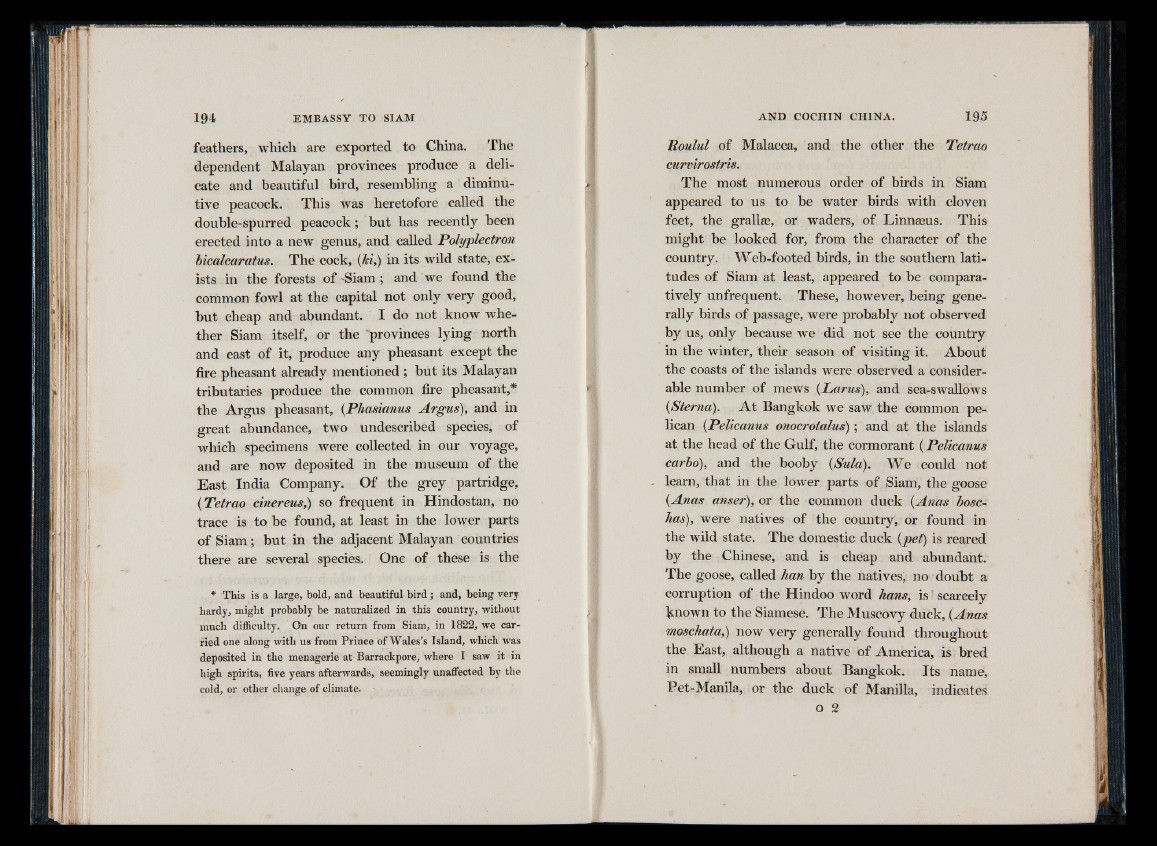
feathers, which are exported to China. The
dependent Malayan provinces produce a delicate
and beautiful bird, resembling a diminutive
peacock. This was heretofore called the
double-spurred peacock; but has recently been
erected into a new genus, and called Polyplectron
bicalcaratus. The cock, {hi,) in its wild state, exists
in the forests of 'Siam ; and we found the
common fowl at the capital not only very good,
but cheap and abundant. I do not know whether
Siam itself, or the ‘provinces lying north
and east of it, produce any pheasant except the
fire pheasant already mentioned ; but its Malayan
tributaries produce the common fire pheasant,*
the Argus pheasant, (Phasianus Argus), and in
great abundance, two undescribed species, of
which specimens were collected in our voyage,
and are now deposited in the museum of the
East India Company. Of the grey partridge,
(Tetrao cinereus,) so frequent in Hindostan, no
trace is to be found, at least in the lower parts
of Siam; but in the adjacent Malayan countries
there are several species. One of these is the
* This is a large, bold, and beautiful bird; and, being very-
hardy, might probably be naturalized in this country, without
much difficulty. On our return from Siam, in 1822, we carried
one along with us from Prince of Wales’s Island, which was
deposited in the menagerie at Barrackpore, where I saw it in
high spirits, five years afterwards, seemingly unaffected by the
cold, or other change of climate.
Roulul of Malacca, and the other the Tetrao
curvirostris.
The most numerous order of birds in Siam
appeared to us to be water birds with cloven
feet, the grallge, or waders, of Linnasus. This
might be looked for, from the character of the
country. Web-footed birds, in the southern latitudes
of Siam at least, appeared to be comparatively
unfrequent. These, however, being generally
birds of passage, were probably not observed
by us, only because we did not see the country
in the winter, their season of visiting it. About
the coasts of the islands were observed a considerable
number of mews (Larus), and sea-swallows
{Sterna). A t Bangkok we saw the common pelican
{Pelicanus onocrotalus); and at the islands
at the head of the Gulf, the cormorant (Pelicanus
carbo), and the booby {Sula). We could not
learn, that in the lower parts of Siam, the goose
{Anas anser), or the common duck {Anas bosc-
has), were natives of the country, or found in
the wild state. The domestic duck {pet) is reared
by the Chinese, and is cheap and abundant.
The goose, called han by the natives, no doubt a
corruption of the Hindoo word bans, is ' scarcely
Jtnown to the Siamese. The Muscovy duck, {Anas
moschata,) now very generally found throughout
the East, although a native of America, is bred
in small numbers about Bangkok. Its name,
Pet-Manila,, or the duck of Manilla, indicates
o 2